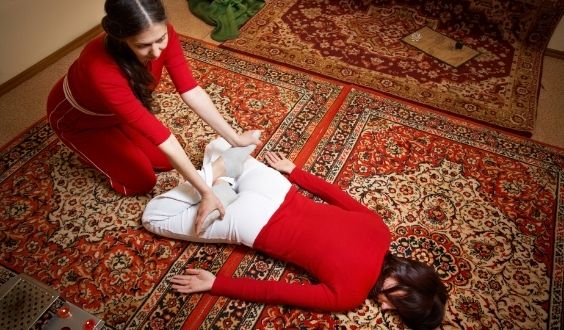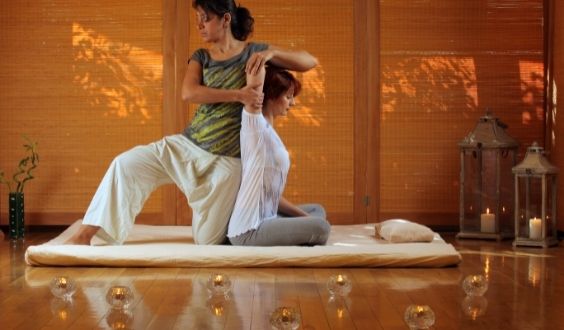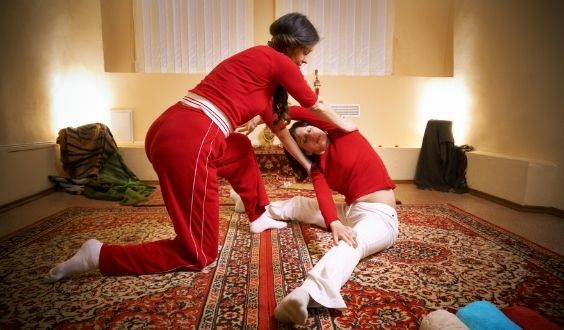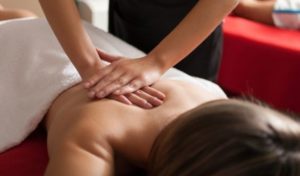The Thai Yoga Massage is a blend of acupressure, yoga, and reflexology. Depending on the needs of the client, this massage can be used to treat specific conditions or simply to relax. Since it uses different positions than traditional massages, it requires training in both yoga and massage therapy.
This form of massage has been practiced for over 2 thousand years in Thailand with different variations developing as it spread throughout Southeast Asia.
If you think this type of massage might be right for you, here’s everything you need to know about it before making an appointment.

What You Need to Know About Thai Yoga Massage
The History of Thai Yoga Massage
The Thai yoga massage was first practiced more than 2000 years ago in Southeast Asia and there are records of Thai people practicing some form of yoga and massage therapy as far back as 200 AD.
Different forms of Thai yoga massage emerged and spread throughout Southeast Asia during the early 11th century. This is when Thai monks were known to practice a form that used acupressure, herbal treatments, and stretching to heal the body.
In an effort to promote Thai culture abroad, Thai ambassadors introduced this type of massage to other countries in the 1960s. Today you can experience Thai yoga massages all around the world – from Europe to South America – with most spas using trained therapists who know how to adapt the techniques for people with different needs.
The Physical Aspect
Just like other types of massages, Thai yoga massages use different techniques that apply pressure to muscle groups through acupressure, gentle stretching, and rhythmic compression. Since Thai massages use a combination of traditional Thai yoga as well as reflexology points on the feet and hands, you will be able to stretch further than with regular forms of massage without injuring any muscles or creating soreness after treatment.
This type of massage often includes full-body stretches and it’s important to communicate if there are any problem areas so therapists can work them out more than others. Thai yoga massage is designed to be a deep massage and therapists will offer just about any posture you’d like during the session – Thai or otherwise. Thai Yoga Massage Therapy Positions:
- The Tree Pose (Vrksasana)
- The Desert Cobra Pose (Sarpasana)
- Child’s Pose
- The Peacock Pose (Mayurasana)
Thai Massages are often done in a Thai-style position where the therapist has access to areas of your body that may not be accessible if performed on a standard table or mat. Although Thai massages do not usually use oils, it is still common for people who book Thai yoga massages to be asked whether they’re sensitive to certain scents or have allergies.
Thai massage is often done for 90 minutes with therapists working on both the head and feet – helping to release tension throughout the body due to not only stretching but rotating pressure points in each section.
This type of massage is meant to be a deep massage and therapists will perform just about any posture you’d like during your session.

The Other Aspects
The Thai Yoga Massage is more than just the physical aspect of the massage. It also includes meditation and self-awareness which focuses on three areas: body, mind, and spirit.
One of the goals of Thai yoga massage is to open up energy channels in order to reduce stress and increase overall relaxation. This can be done with out using any lotions or oils making it perfect for people who are sensitive to additional scents or chemicals found in other types of massages.
Thai Yoga massages are typically performed for 90 minutes with therapists working on both your head and feet which help release tension throughout the body due to not only stretching – but also by rotating pressure points in each section.
Thai massage is also known as energetic-reciprocal and Thai yoga massages focus on energy lines throughout the body allowing them to flow properly.
The Pros and Cons Of Thai Yoga Massage
Pros
This Thai massage is a deep-tissue massage that allows you to stretch further without injuring muscle tissue. It is gentle enough for people with injuries or conditions. The Thai style allows you to communicate more effectively about problem areas with the therapist in order to avoid potential injury due to stretching too far, too quickly.
Other benefits include the relief of pain and stiffness in joints, relief from migraines and headaches, improved blood circulation, relaxed nervous system, reduced stress, and improved energy levels just to name a few.

Cons
Thai Yoga Massage Therapy Drawbacks Thai Yoga massages are often done in Thai-style positions which can be difficult for people with limited mobility or chronic pain.
In addition, people who want to get Thai yoga massages must be careful with existing health conditions. Conditions like diabetes, high blood pressure, neurological diseases, and coronary artery diseases are just a few conditions that may require people to speak to their physician first.
At the same time, people with cancer and women that are pregnant should not go for Thai yoga massages.
Balance for the Body, Spirit, and Mind
Thai yoga massage therapy is a holistic approach to wellness that balances the body, mind, and spirit. If you are ready for an experience which restores your energy, improves circulation, relieves stress, and heals old injuries and chronic pain, schedule an appointment for a Thai yoga massage today.
You might also wanna check the Top 5 Reasons You Should Get A Foot Massage.



